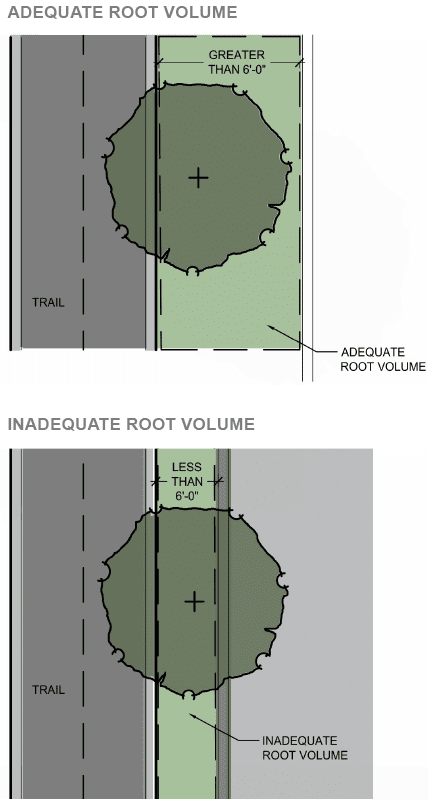While designs often consider the mature canopy of a tree, the requirements for root areas are often forgotten.
This leads to trees with shortened lifespans and negative impacts on surrounding surfaces and structures. The most effective way to design for a tree is to design with consideration for the tree’s mature canopy. If a tree will eventually have a crown projection of 30’-0” diameter, pavements and their required compaction will have a negative impact on the tree anywhere within that circle as it is inscribed on the ground.
 Step 1: Determine root volume needed
Step 1: Determine root volume needed
- Two cubic feet of soil is needed for every square foot of crown projection. This is the anticipated area under the drip line of the tree at expected maturity. This formula does not apply to fastigiate and columnar habit trees. The soil volume requirement can be calculated for narrow form trees by basing the canopy diameter on the parent tree’s natural growth form.
- Consider functional soil volume to be no deeper than 3’-0” for tree root area.
- If a pavement barrier is only present to one side of tree, root volume can be considered in the remaining area as long as no other obstructions are present (root barrier should be used along pavement).
- When an obstruction is present on 2 or more sides of the tree within the Critical Root Zone (CRZ), tree roots can extend longitudinally following the uncompacted soils. The longitudinal measure must be long enough to meet the volume requirements. However, if the space between the obstructions is less than 6’-0” wide the soil volume should be considered inadequate for mature canopy development.
Step 2: If volume is inadequate
- Preferred Method: Either select an alternative tree with a smaller growth habit, i.e. ornamental tree in lieu of a canopy tree, or select and alternative location for tree placement.
- Alternative Method: Utilize root volume structures to meet the growth needs for the selected/desired tree.
APPLICATION: (NEW CONSTRUCTION)
Where additional root volume is required, structural root cells or structural soils can be incorporated to effectively increase the available root area. Cells or structural soil can also be used to “bridge” under pavements, allowing access to larger unobstructed soil areas on the opposite side.
Root cells such as Silva Cells and Strata Cells (Preferred)
These support surrounding pavements, eliminating the need for compaction in the critical root zone. Cells are preferred to structural soil, as studies have shown that trees are significantly healthier, with higher growth rates and longer-life expectancy.
- In confined areas, these cells can be used in multiple tiers to minimize excavation, however; functional soil volume should be considered no deeper than 3’-0”.
- Cells should be installed per manufacturer’s specifications.
- They can also be counted for stormwater credits, where applicable.
Structural Soil (Alternative)
Structural soils are patented soil mixtures consisting of large quantities of graded aggregates. They are designed to support pavements, permitting required compaction, while having void space for tree roots.
- The relatively low quantity of soil leads to fast draining, fast drying conditions. Trees should be selected for drought tolerance.
